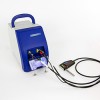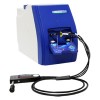
Medical & Biomedical Diagnostics
Raman spectroscopy is becoming more pervasive in biomedical diagnostics because of the demand for near real time and minimally invasive analysis at the point of care. Raman is an ideal technique for molecular fingerprinting and is sensitive to the chemical changes associated with disease.
Biomedical science is one of the most exciting application areas of Raman spectroscopy because it can accomplish the diagnosis of disease at an early stage. Raman is a nondestructive technique that can be used for analysis including in vivo studies of tissues and cells, minimizing the need for tissue incisions. There is an increasing use of Raman for clinical applications because Raman is an ideal technique for molecular fingerprinting and is sensitive to the chemical changes associated with disease. Furthermore, components in the tissue matrix, principally those associated with water and bodily fluids, give a weak Raman response, thereby improving sensitivity to spectral signal changes associated with a diseased state. Raman analysis has been used for rapid in vivo screening for breast and cervical cancer, gastrointestinal tumors, cerebrospinal fluid related to spinal cord injuries, and many more medical diagnoses.
Biomedical Raman applications include: examination of biopsies, cytology, drug efficacy studies, histopathology, better defining surgical targets and the interface between malignant and healthy tissue, and treatment monitoring.
Some of the most active research areas are the analysis of abnormalities in tissue samples such as brain, arteries, breast, bone, cervix, embryonic media; and the identification of biomarkers for early stage detection of breast, cervical, and pancreatic cancer.
Raman has also been used to investigate blood disorders such as anemia and leukemia, as well as understanding cell growth in bacteria, phytoplankton, viruses and other micro-organisms.
The portability of the i-Raman series instruments makes them ideal for rapid diagnostics of at the point of care. They can be used in vivo during surgery, or near the clinical settings for rapid screening of biopsy samples to identify malignant and benign tissue. The i-Raman series instruments are available with 532, 785, or 1064-nm excitation laser.


